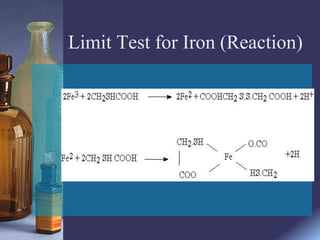Test of Purity
- 1. PHAR 111 Inorganic Pharmaceutical Chemistry 45 Hours -Kabin Maleku
- 2. Unit 1 (1 Hr) • Test of Purity, • Importance of limit test and • General principles of limit tests for chloride, sulphate and iron.
- 3. WHAT IS PURE? Test of Purity
- 4. Definition • Purity vs Impurity • Purity by Assay of Drug Substance • Impurity by assay of Impurities
- 5. Purity • Purity by Assay of Drug Substance • Comparison with reference standard
- 6. Impurity • Any substance apart from the substance of interest are impurities • Low concentration • Any substance that affects the purity of material of interest • Pharmaceutical impurity testing and assay is vital to addressing the purity, safety and quality of drug substances or finished drug products.
- 7. Sources of Impurity • Starting materials and their contaminants, • Reagents, • Catalysts, • Solvents, • Intermediates, • Excipients and their contaminants, • Leachables and • Degradation products.
- 8. Classification Impurity • Organic impurities (process- and drug- related) • Inorganic impurities (Elemental impurities) • Residual solvents
- 9. Limit Test • Limit test is a Qualitative and semi qualitative • Comparative with unknown with known standard • Limit test for Sulphide, Chloride, Iron, Arsenic, Heavy metals, Lead • Provided in terms of Parts per million/billions • (ppm=1ug=10^-6gm)
- 10. Importance of Limit Test • Why?
- 11. General principle of Limit Test Comparison with standard Comparasion by Opalescence, Turbidity, Colour, Stain with standard and test samples Test and standard should be prepared at same conditions and same time Reagents should be specific so that minimise errors
- 12. General principle of Limit Test Nessler Cylinder (Colorless glass, uniform diameter, Flat and transparent base with nominal capacity of 50 ml and 150 mm minimum height ) Specific reagents in dilute and solution form Same procedure is followed with both test and standard
- 13. Limit Test for Chloride Principle: Soluble chloride to be reacted with silver nitrate to form silver chloride which appears opalescence.
- 14. Limit Test for Chloride (Procedure) Test Standard Specific weight of compound is dissolved in water or solution is prepared as directed in the pharmacopoeia and transferred in Nessler cylinder Take 1ml of 0.05845 % W/V solution of sodium chloride in Nessler cylinder Add 1ml of nitric acid Add 1ml of nitric acid Dilute to 45 ml in Nessler cylinder Dilute to 45 ml in Nessler cylinder Add 1ml of AgNO3 solution Add 1ml of AgNO3 solution Keep aside for 5 min Keep aside for 5 min Observe the Turbidity/Opalescence
- 15. Limit Test for Chloride Inference: 1. Test pass or Fail Reason: Nitric acid is added in the limit test of chloride to make solution acidic and helps silver chloride precipitate to make solution turbid at the end of process
- 16. Limit Test for Sulphates Principle: Limit test of sulphate is based on the reaction of soluble sulphate with barium chloride in presence of dilute hydrochloric acid to form barium sulphate which appears as solid particles (turbidity) in the solution
- 17. Limit Test for Sulphates (Procedure:)) Test Standard Specific weight of compound is dissolved in water or solution is prepared as directed in the pharmacopoeia and transferred in Nessler cylinder Take 1ml of 0.1089 % W/V solution of potassium sulphate in Nessler cylinder Add 2ml of dilute hydrochloric acid Add 2ml of dilute hydrochloric acid Dilute to 45 ml in Nessler cylinder Dilute to 45 ml in Nessler cylinder Add 5ml of barium sulphate reagent Add 5ml of barium sulphate reagent Keep aside for 5 min Keep aside for 5 min Observe the Turbidity
- 18. Limit Test for Sulphate Barium sulphate reagent contains barium chloride, sulphate free alcohol and small amount of potassium sulphate. Inference: 1. Test pass or Fail Reason: Hydrochloric acid helps to make solution acidic. Potassium sulphate is used to increase the sensitivity of the test by giving ionic concentration in the reagent Alcohol helps to prevent super saturation.
- 19. Limit Test for Iron • Principle: • Limit test of Iron is based on the reaction of iron in ammonical solution with thioglycollic acid in presence of citric acid to form iron thioglycolate which is pale pink to deep reddish purple in color
- 20. Limit Test for Iron (Procedure:)) Test Standard Sample is dissolved in specific amount of water and then volume is made up to 40 ml 2 ml of standard solution of iron diluted with water upto 40ml. (ferric ammonium sulfate- standard) Add 2 ml of 20 % w/v of citric acid (iron free) Add 2 ml of 20 % w/v of citric acid (iron free) Add 2 ml of 20 % w/v of citric acid (iron free) Add 2 ml of 20 % w/v of citric acid (iron free) Add ammonia to make the solution alkaline and adjust the volume to 50 ml Add ammonia to make the solution alkaline and adjust the volume to 50 ml Keep aside for 5 min Keep aside for 5 min Color developed is viewed vertically and compared with standard solution
- 21. Limit Test for Iron (Reaction)
- 22. Limit Test for Iron Earlier aamoniumthiocyanate reagent was used for the limit test of iron. Since thioglycolic acid is more sensitive reagent, it has replaced ammonium thiocyanate in the test. Inference: 1. Test pass or Fail Reason: • Citric acid helps precipitation of iron by ammonia by forming a complex with it. • • Thioglycolic acid helps to oxidize iron (II) to iron (III). • Ammonia to make solution alkaline.






















